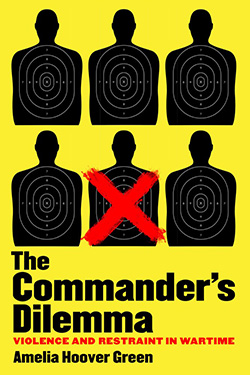"The Commander's Dilemma": Q&A on Wartime Violence
February 1, 2019
Why do some military groups commit many types of violence, whereas others carefully control violence against citizens? In her new book “The Commander’s Dilemma: Violence and Restraint in Wartime,” Cornell University Press, Assistant Professor of Politics Amelia Hoover Green, PhD — whose research focuses on conflict-related violence, intra-armed groups and human rights — argues that restraint occurs when fighters understand why they are fighting. That is, when commanders invest in political education.
Hoover Green’s book was shortlisted for the Conflict Research Society Book of the Year Prize, an annual award that honors “research that is contemporary, exceptional and world leading, and which provides an invaluable contribution to the literary on conflict and peace studies, very broadly defined.”
 Amelia Hoover Green, PhD
Amelia Hoover Green, PhD
First things first: What is the commander’s dilemma?
The commander’s dilemma is a catch-22 that I first noticed when I started to interview military officers and lawyers in El Salvador. Basically, in order to win a war, commanders have to create a big group of people willing to use violence with little hesitation. But also, in order to win a war, commanders have to maintain at least some control of the violence that combatants use, because armed groups that use violence indiscriminately generally do not succeed in their objectives (i.e., they lose).
The commander’s dilemma is the name I give to this problem, wherein commanders have to thread the needle of turning people violent but also making sure that violence remains under control. The ways that they choose to resolve that catch-22 have a big impact on repertoires of violence against civilians.
Explain this idea of repertoires of violence — it goes beyond lethal violence, correct?
Correct! The “repertoire of violence” is a metaphor from an artistic repertoire: the set of works that an artist typically draws on, or is prepared to perform. In the context of violence against civilians, a repertoire refers to the types of violence that an armed group typically uses, and their relative proportions.
It might be narrow (always just one or a few types of violence) or broad (many types of violence). This is separate from the level of violence, and I think that is one of the key contributions of the book. Usually when we think about “violence against civilians” we are implicitly thinking about “the level of lethal violence against civilians,” i.e., counting the number of killings.
Your book describes some of the shortcomings of examining wartime violence from a purely quantitative perspective. Why was it important to draw on multiple disciplines?
I came to this topic via research on sexual violence during war, and I repeatedly observed that simply counting deaths didn’t do justice to the narratives of violence that victims of violence tell. I looked at work from a ton of sources and disciplines to try to get at the “texture” (if you will) of violence narratives. The simple fact is that the majority of civilian victims of armed conflict survive, and many of these suffer more than one form of violence. I wanted to take a stab at understanding why narratives that describe the same number of deaths often sound so different.
Some of the research for your book took place in El Salvador. Could you describe some of your experiences and scholarly activities there?
El Salvador is one of my favorite places in the world — particularly rural El Salvador, which, for a person originally from North Dakota, is completely stunning to see: rolling mountains, dense jungle, colorful birds and “birds of paradise,” which are actually flowers. And coffee! Some of the best shade-grown coffee in the world comes from El Salvador.
One of the things I love about El Salvador is also one of the things that I love about Philly: murals. When I’m there, I try to see all the murals and public art commemorating Óscar Romero that I can. Romero was the Archbishop of San Salvador; his radio sermons helped rally people against government violence and economic oppression. Many see his assassination (by the government, via a bullet to the heart, while he was saying Mass) as one of the things that made war inevitable. He was killed in 1980 and canonized last year.
I also think a lot about what it means to research El Salvador as an American. Much of the country’s suffering in the 20th century is down to American foreign policy and intervention, and people know that. It’s on me to craft interviews carefully, to give people reason to speak freely, to respect the fact that they know so much more than me and that there might be conflicts between my research process and my ethical obligations to those who participate in my research.

Your book speaks to the power of political education. Does your research have any bearing on how you see your role as a politics professor?
It does. Political education is so key in armed organizations because it is how soldiers learn what, precisely, they are fighting for. It can’t be something vague like “yay democracy.” It has to be a fleshed-out, finely drawn, detailed set of ideas. The way I apply that in my teaching is that my job is to add the sort of detail and specificity that can sustain the interest, and the ethical purpose, that students bring to my classrooms.
You write that, when thinking about the policy implications of studies of wartime violence, “solutions are often vastly more complex than a single study can comprehend.” Despite the challenges, what do you see as some of the potential applications of your work?
Notwithstanding my impulse to hedge my bets, I see three big implications for policy. First, groups without strong internal institutions, particularly political education, are likely to commit wider repertoires of violence. Consequently, humanitarians should be particularly watching these groups as risks for widespread non-lethal violence. This is important because different patterns of violence require different sorts of aid to survivors.
Second, armed groups themselves often want to do right by civilians, because that is the way to win a war. The book suggests that a key way to control violence against civilians is by educating fighters about the political and social purposes of the war.
The third implication is maybe the toughest, especially for state militaries and civilian political leaders. It suggests that, without a clear, detailed sense of the purpose of a war that soldiers buy into in a deep way, there will be more violence against civilians. This insight makes me think a lot about what our military is doing in Iraq and Afghanistan, for example, where there’s little clarity on what sort of practical transformation we’re hoping to effect. I value and admire my military and veteran students, and I worry a lot about the situations their leaders put them in.
Do you plan to expand on this scholarship? What’s next for your research and teaching?
Yes! I have an ongoing project that is gathering data on armed group institutions throughout the world, and another where I am building methodological tools to assess data quality in conflict studies. As a (probable) tenure present to myself, next year I’m teaching a special topics course on Apocalypse, Dystopia and Political Science.
“The Commander’s Dilemma” is available for purchase at Cornell University Press. Drexel students, faculty and staff can also access the full PDF version for free via the Drexel University Libraries.